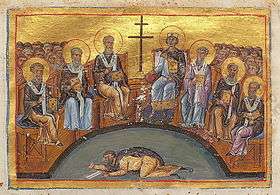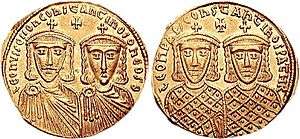Constantine VI
Constantine VI (Ancient Greek: Κωνσταντῖνος Ϛ΄, Kōnstantinos VI; 771 – before 805[1]) was Byzantine Emperor from 780 to 797. The only child of Emperor Leo IV, Constantine was named co-emperor with him at the age of five in 776 and succeeded him as sole Emperor in 780, aged nine. His mother Irene exercised control over him as regent until 790, assisted by her chief minister Staurakios, and eventually Constantine ruled himself, until his mother blinded and deposed him.
| Constantine VI | |
|---|---|
| Emperor of the Romans | |
 Constantine VI (right to the cross) presiding over the Second Council of Nicaea. Miniature from early 11th century. | |
| Emperor of the Byzantine Empire | |
| Reign | 8 September 780 – 19 April 797 (with Irene) |
| Predecessor | Leo IV |
| Successor | Irene |
| Coregency | Irene |
| regency and Real ruler | Irene |
| Born | 771 |
| Died | before 805 |
| Wives | |
| Issue | Euphrosyne Irene Leo |
| Dynasty | Isaurian Dynasty |
| Father | Leo IV |
| Mother | Irene |
| Isaurian or Syrian dynasty | |||
| Chronology | |||
| Leo III | 717–741 | ||
| with Constantine V as co-emperor, 720–741 | |||
| Constantine V | 741–775 | ||
| with Leo IV as co-emperor, 751–775 | |||
| Artabasdos' usurpation | 741–743 | ||
| Leo IV | 775–780 | ||
| with Constantine VI as co-emperor, 776–780 | |||
| Constantine VI | 780–797 | ||
| under Irene as regent, 780–790, and with her as co-regent, 792–797 | |||
| Irene as empress regnant | 797–802 | ||
| Succession | |||
| Preceded by Twenty Years' Anarchy |
Followed by Nikephorian dynasty | ||
Though the regency lost power when Constantine reached maturity in 790, Irene continued to attempt to exercise control, and retained the title of Empress. Constantine suffered military defeats and made unpopular decisions, such as marrying his mistress, Theodote. Irene had Constantine deposed, blinded and imprisoned in 797 and seized power for herself, becoming the first Empress regnant of the Empire. Constantine likely died shortly thereafter.
Constantine VI was the final ruler to be universally recognized as Roman Emperor, being recognized as such by both the Empire which he ruled in the east, the papacy and the Western European powers over which the pope held suzerainty. With his mother becoming Empress regnant upon his deposition, the papacy crowned Charlemagne as a new Emperor in Western Europe, asserting that a woman could not be Empress in her own right. This laid the foundations of a new polity, independent of the East, that would evolve into the Holy Roman Empire.[2]
Early life and the regency of Irene
Constantine VI was the only child of Emperor Leo IV and Irene. Constantine was crowned co-emperor by his father in 776, and succeeded as sole emperor in 780, at the age of nine. Due to his minority, Irene and her chief minister Staurakios exercised the regency for him.[1]
In 787 Constantine had signed the decrees of the Second Council of Nicaea, but he appears to have had iconoclast sympathies.[1] By then Constantine had turned 16 years old, but his mother did not relinquish executive authority to him.
In 788, Irene herself broke off the engagement of Constantine with Rotrude, a daughter of Charlemagne. Turning against Charlemagne, the Eastern Romans now supported Lombard pretender Adalgis, who had been forced into exile after the Frankish invasion of Italy. Adalgis was given command of a Roman expeditionary corps, landing in Calabria towards the end of 788 but was defeated by the united armies of the Lombard dukes Hildeprand of Spoleto and Grimoald III of Benevento as well as Frankish troops under Winiges.[3]
After a conspiracy against Irene was suppressed in the spring of 790 she attempted to get official recognition as empress. This backfired and with military support Constantine finally came to actual power in 790, after the Armeniacs rebelled against Irene. Nevertheless, after campaigning unsuccessfully in the Balkans, Constantine restored his mother in 792 after just two years out of power.[4]
Reign
Once in control of the state, Constantine proved incapable of sound governance. His army was defeated by the Muslims, and Constantine himself suffered a humiliating defeat at the hands of Kardam of Bulgaria in the 792 Battle of Marcellae.[1] A movement developed in favor of his uncle, the Caesar Nikephoros. Constantine had his uncle's eyes put out and the tongues of his father's four other half-brothers cut off. His former Armenian supporters revolted after he had blinded their general Alexios Mosele. He crushed this revolt with extreme cruelty in 793.[1]
He then divorced his wife Maria of Amnia, who had failed to provide him with a male heir, and married his mistress Theodote, an unpopular and canonically illegal act which sparked off the so-called "Moechian Controversy". Although the Patriarch Tarasios did not publicly speak against it, he did refuse to officiate the marriage. Popular disapproval was expressed by Theodote's uncle, Plato of Sakkoudion, who even broke communion with Tarasios for his passive stance. Plato's intransigence led to his own imprisonment, while his monastic supporters were persecuted and exiled to Thessalonica. The "Moechian Controversy" cost Constantine what popularity he had left, especially in the church establishment, which Irene took care to vocally support against her own son.[1][5][6]
On 19 April 797 Constantine was captured, blinded, and imprisoned by the supporters of his mother, who had organized a conspiracy, leaving Irene to be crowned as first Empress regnant of Constantinople. It is unknown when exactly Constantine died; it was certainly before 805, but he very likely died of his wounds shortly after being blinded. He was buried in the Monastery of St. Euphrosyne, which Irene had founded.[1][5][7]
In the early 820s, the rebel Thomas the Slav claimed to be Constantine VI in an effort to gain support against Michael II.[8]
Family

By his first wife Maria, Constantine VI had two daughters:[9]
- Euphrosyne (790 – after 836), who married Emperor Michael II
- Irene (789 – after July 796), who became a nun
By his mistress and then second wife Theodote, Constantine VI had two sons, both of whom died young:[9]
- Leo (7 October 796 – 1 May 797)
- An unnamed son (posthumously 797/8 – between 802 and 808)
See also
References
- Cutler & Hollingsworth (1991), pp. 501–502
- James Bryce, 1st Viscount Bryce, The Holy Roman Empire, 1864, pp 62–64
- Ottorino Bertolini, "Adelchi, re dei Longobardi", Dizionario Biografico degli Italiani 1 (1960).
- "Constantine VI (780-797)", Dumbarton Oaks
- Treadgold (1997), p. 422
- Garland (1999), pp. 84–85
- Garland (1999), pp. 85–87, 260 (Note 67)
- Treadgold (1997), p. 435
- Crawley, Charles (29 May 2014). "BYZANTIUM 395-1057". Medieval Lands (3rd ed.). Retrieved 17 April 2018 – via Foundation for Medieval Genealogy.
Sources
- Ostrogorsky, George (1956). History of the Byzantine State. Oxford: Basil Blackwell.CS1 maint: ref=harv (link)
- Cutler, Anthony; Hollingsworth, Paul A. (1991). "Constantine VI". The Oxford Dictionary of Byzantium. Oxford and New York: Oxford University Press. pp. 501–502. ISBN 0-19-504652-8..
- Garland, Lynda (1999). Byzantine Empresses: Women and Power in Byzantium, AD 527–1204. New York and London: Routledge. ISBN 978-0-415-14688-3.
- Treadgold, Warren (1997). A History of the Byzantine State and Society. Stanford, California: Stanford University Press. ISBN 0-8047-2630-2.
- Dominique Barbe, Irène de Byzance: La femme empereur, Paris, 1990.
Constantine VI Born: 771 Died: before 805 | ||
| Regnal titles | ||
|---|---|---|
| Preceded by Leo IV |
Byzantine Emperor 8 September 780 – 19 April 797 With Irene |
Succeeded by Irene |